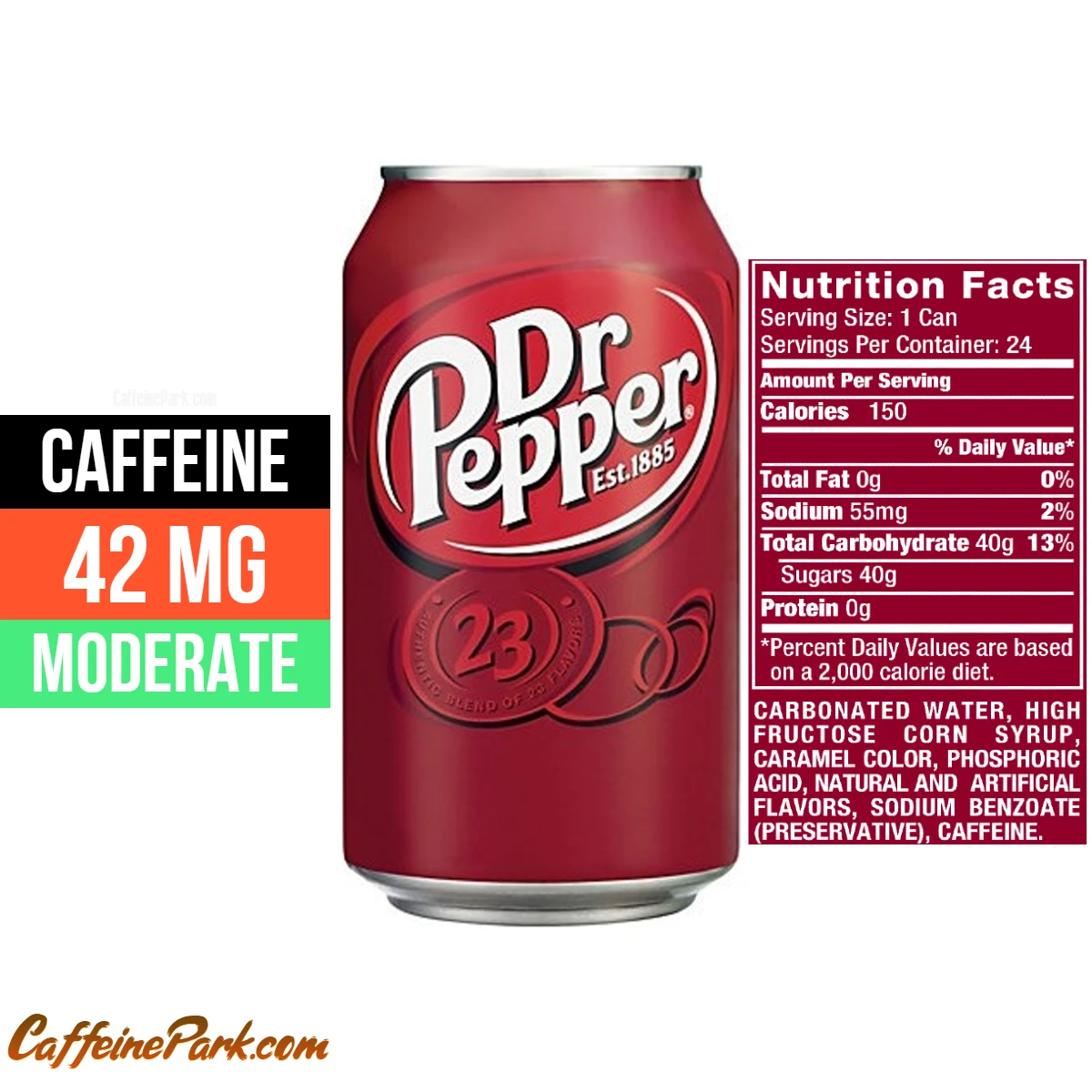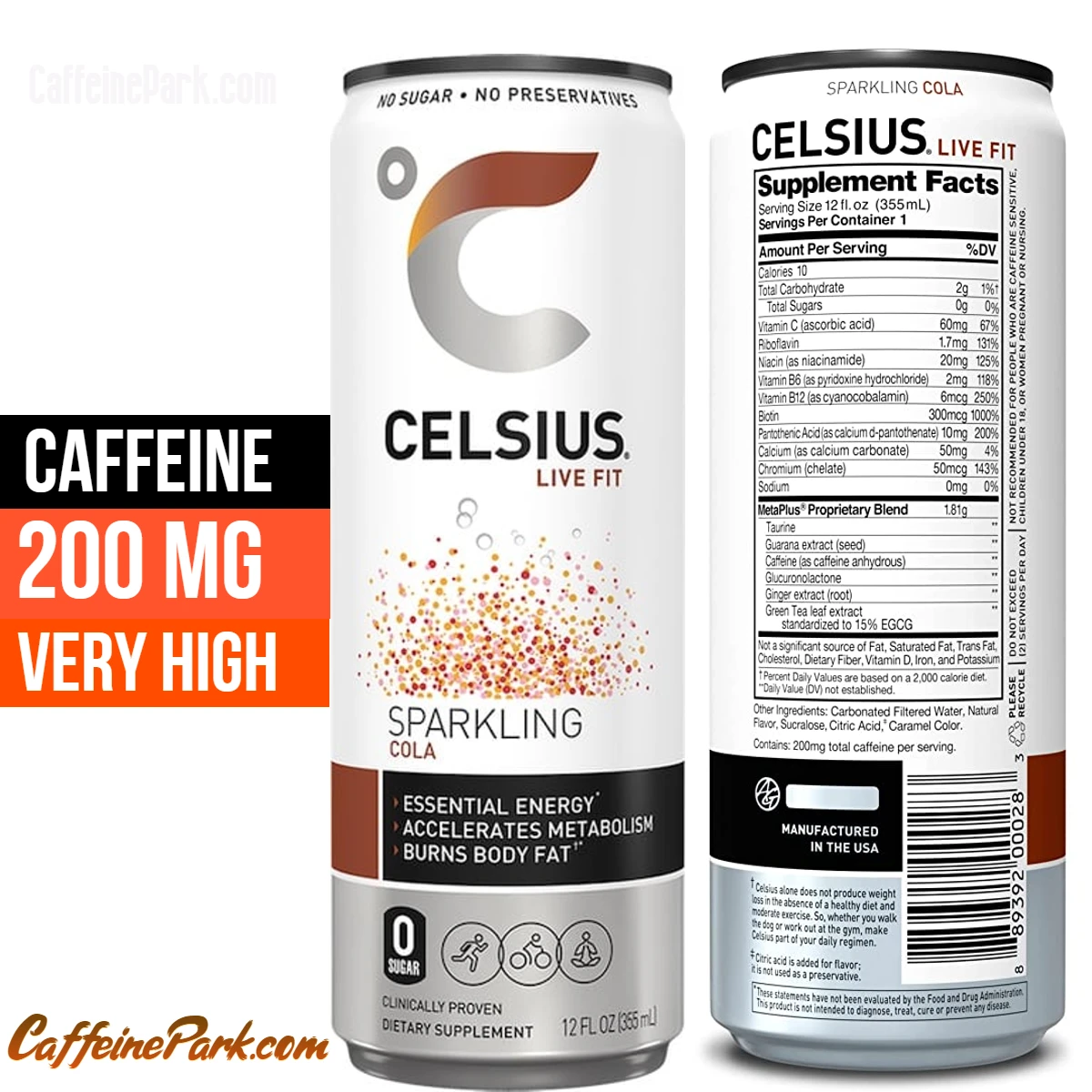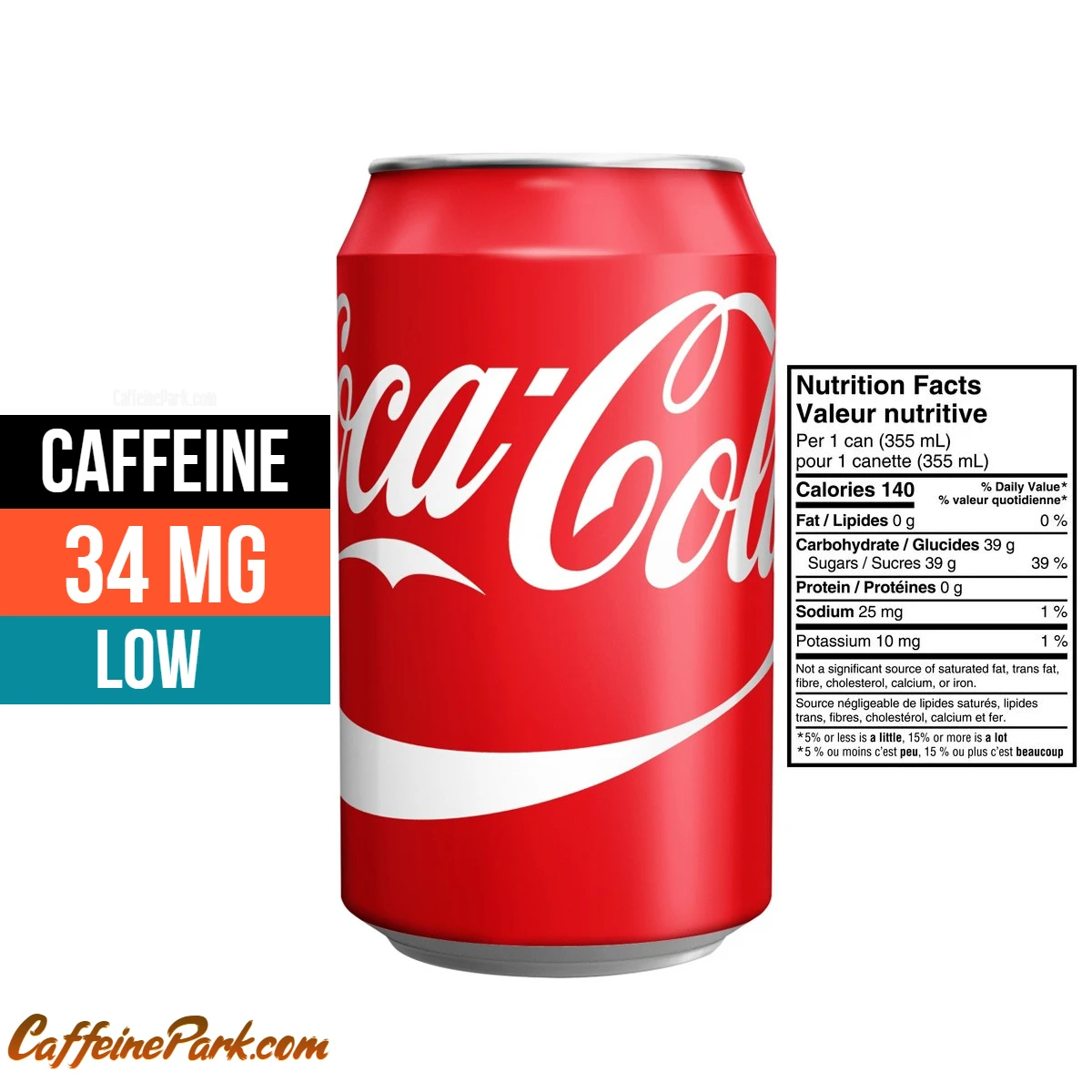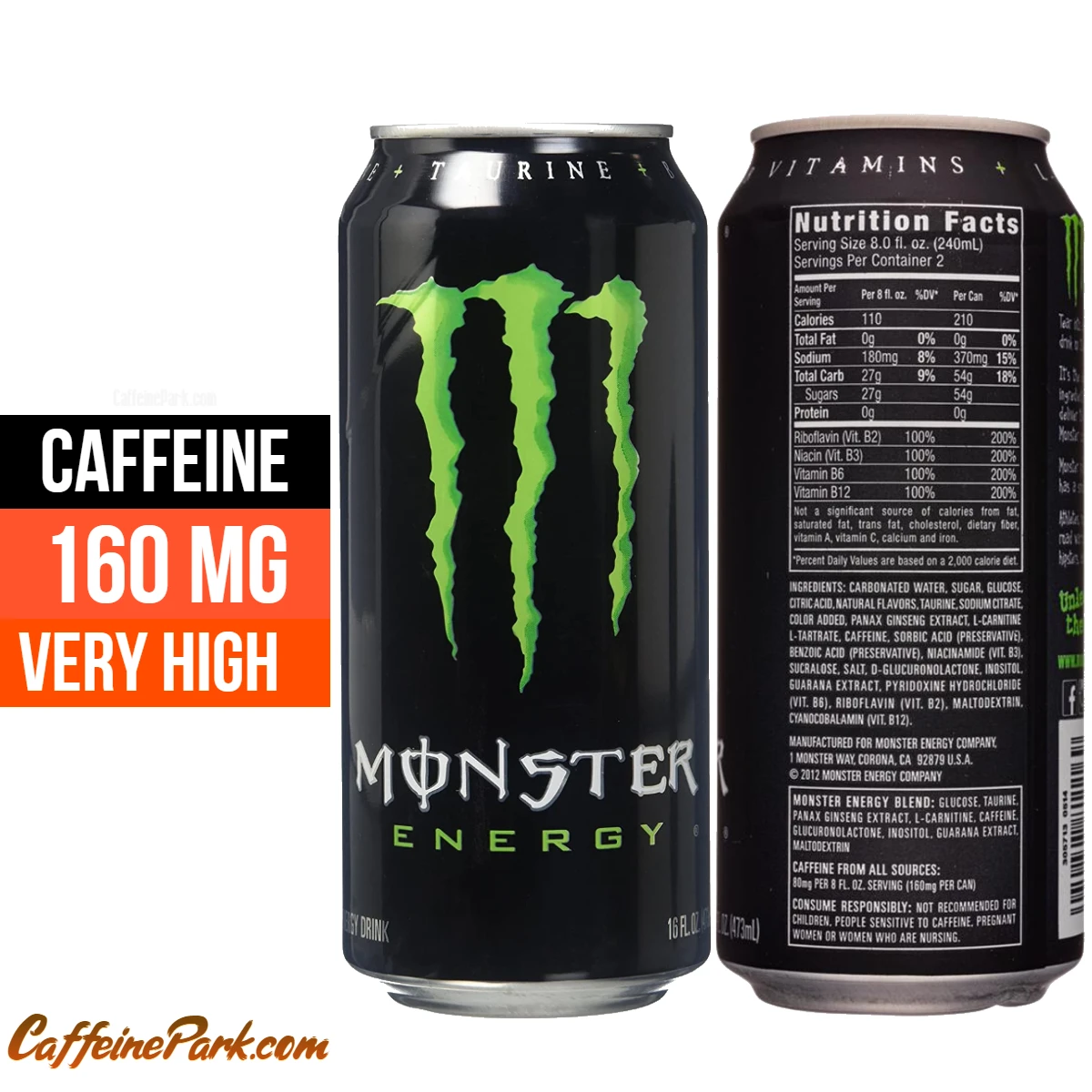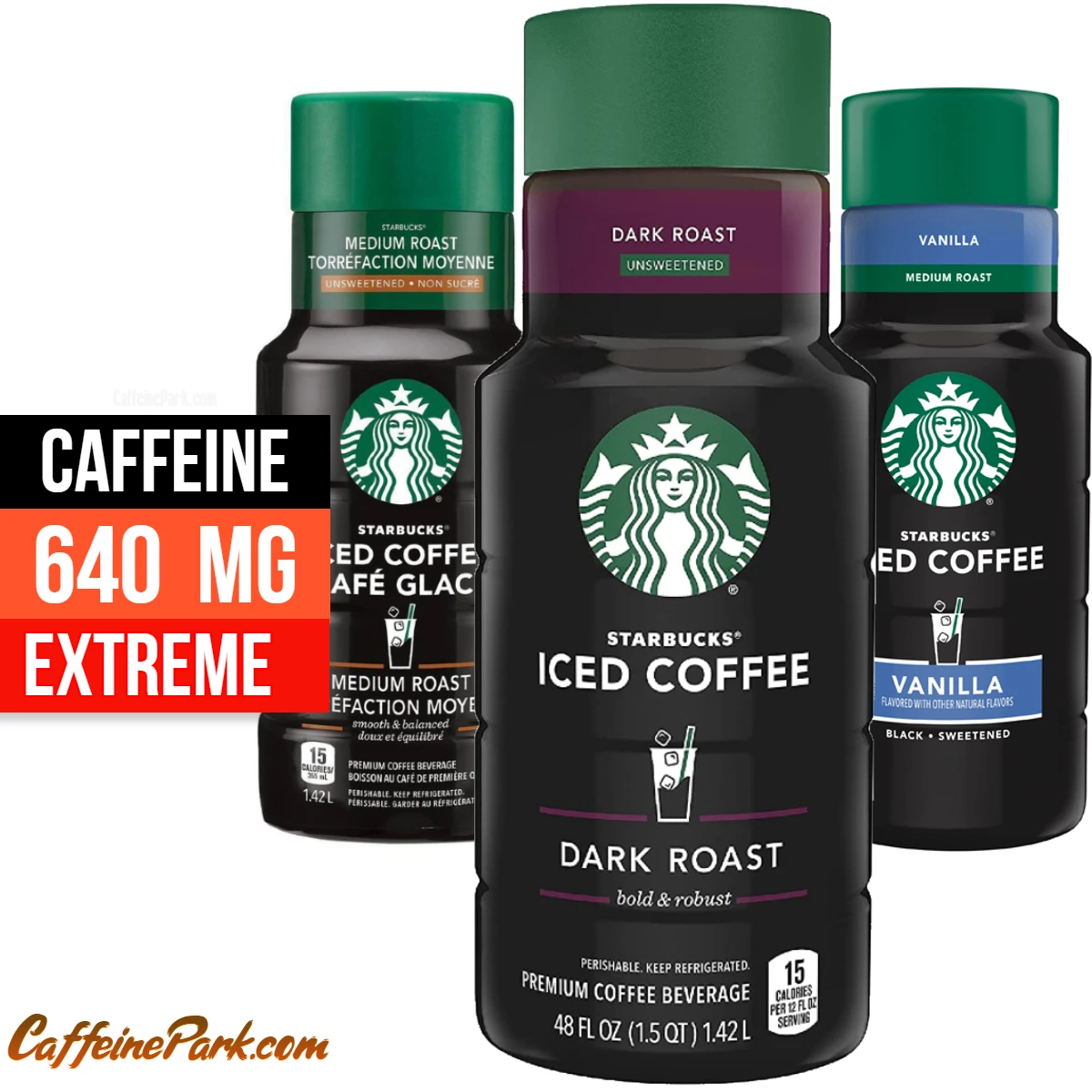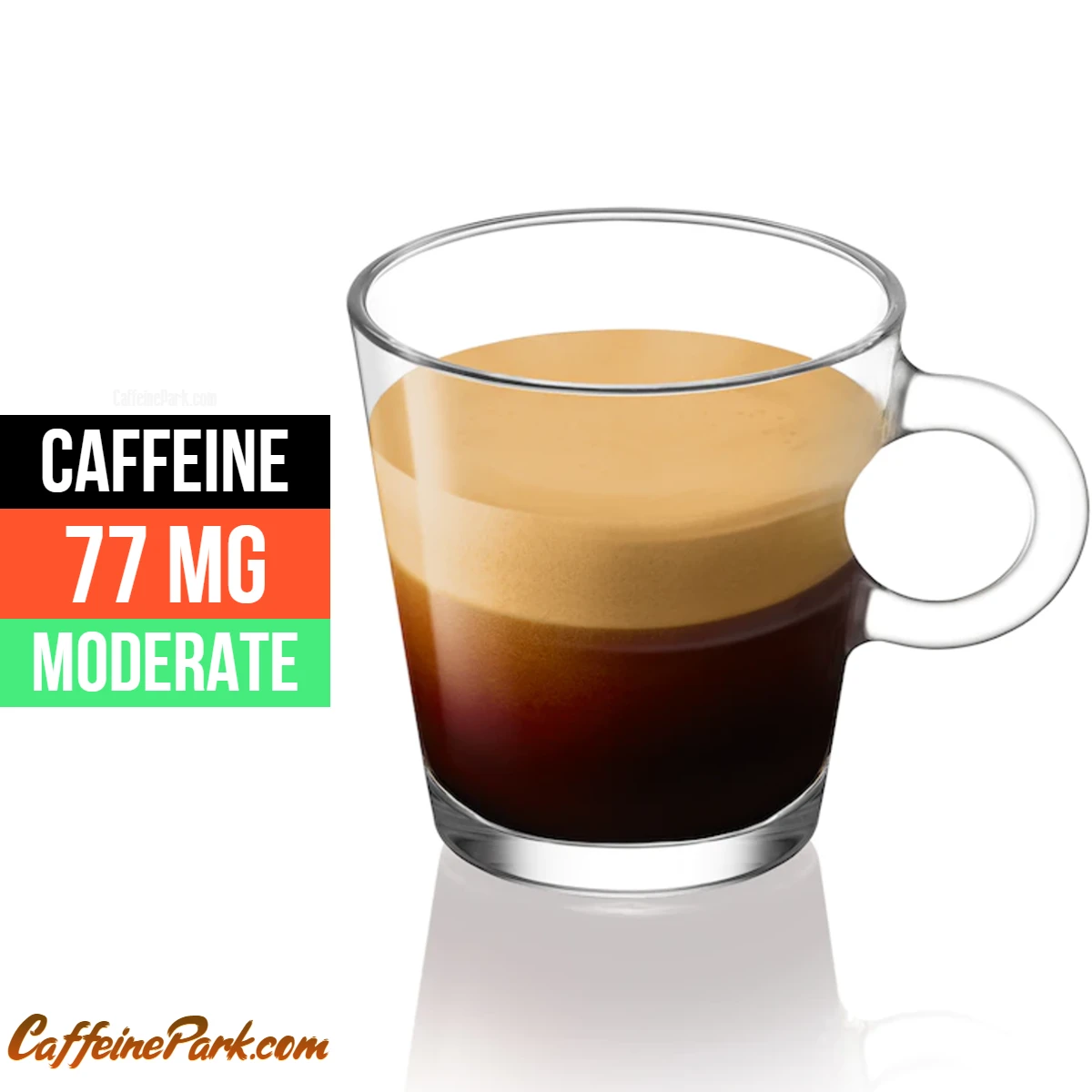
Does Espresso have caffeine?
Yes, a single shot (1 oz) of Espresso contains 64 mg of caffeine and a shot (1.5 oz) contains 77 mg of caffeine, which is a double shot of espresso has 154 mg of caffeine, which means 51.33mg of caffeine per fl oz (173.58mg per 100ml).
- Caffeine Amount: 64 mg
- Caffeine strength: MODERATE
- Calories: 0cal
- Serving size: 1.5 fl oz
| Serving size | Caffeine Amount | Caffeine strength |
|---|---|---|
| Ristretto shot (20ml) | 35 mg | LOW |
| a single shot (1 ounce/30ml) | 64 mg | MODERATE |
| 1.5 fl oz shot (40ml) | 77 mg | MODERATE |
| double shot/doppio (2 ounces/60ml) | 154 mg | VERY HIGH |
| 100ml | 174 mg | VERY HIGH |
Espresso is a method of brewing coffee in which pressurized hot water is forced through finely-ground coffee beans. The result is a concentrated and flavorful shot of coffee, typically served in small portions. Espresso is the base for many popular coffee drinks, such as lattes, cappuccinos, and Americanos. It is made using an espresso machine, which uses high pressure to force hot water through finely-ground coffee. The process typically takes 20-30 seconds.
Many people think espresso isn’t really coffee. They think that an espresso shot is made using only strong coffee beans and no milk. I can tell you that they’re wrong! An espresso shot is made from the same coffee beans, whether it is Arabica or Robusta, used to make regular drip coffee. The difference lies in how the coffee is prepared.
Here is an approximate range of caffeine content for some common espresso drinks:
- Single shot espresso (30 ml): 64 mg of caffeine
- A shot of espresso (40 ml): 77 mg of caffeine
- Double shot espresso (60 ml or 2 oz): 154 mg of caffeine
- Ristretto (15-20 ml): 64 mg of caffeine
- Lungo (120 ml or 4 oz): 94 mg of caffeine
- Doppio (double shot espresso, 60 ml or 2 oz): 154 mg of caffeine
A shot of espresso is typically considered to be around 1 ounce (30 mL) of liquid. It is made by forcing pressurized hot water through finely-ground coffee beans, resulting in a concentrated and flavorful shot of coffee. The typical caffeine content in a shot of espresso is around 64 milligrams of caffeine.
A double shot of espresso, also known as a “doppio,” is essentially two shots of espresso in one cup. It is typically 2 ounces (60 mL) of liquid and has around 154 milligrams of caffeine. The double shot is a stronger and more intense version of a regular espresso shot.
The result is a very strong cup of coffee that is topped with a thick layer of foamy cream. Espresso coffee is made from 7 grams of fine ground coffee, extracted to 1.5 ounces (40ml) over about 25 seconds, then topped with a golden creamy (creme) color caffeine content containing about 77 milligrams of caffeine.
It’s important to note that the caffeine content can vary depending on the type of coffee beans used, the roast of the beans, and the brewing method. Additionally, other coffee drinks such as lattes, cappuccinos, and Americanos, often use shots of espresso as their base, so the caffeine content can vary depending on the size and number of shots used in the drink.
As a general rule of thumb, it is recommended that healthy adults consume no more than 400 mg of caffeine per day. However, individual tolerance to caffeine can vary greatly, so it’s important to pay attention to how your body reacts to different levels of caffeine consumption.
Caffeine in Espresso Based Drinks
| Espresso Based Drinks | Serving Size (oz) | Caffeine (mg) |
|---|---|---|
| Cappuccino | 12 fl oz. | 154mg |
| Latte | 16 fl oz. | 154mg |
| Caffe Mocha | 12 fl oz. | 152mg |
| Americano Coffee | 12 fl oz. | 154mg |
| Flat White | 12 fl oz. | 130mg |
| Starbucks Grande Cappuccino | 16 fl oz. | 150mg |
| Peet’s Cappuccino | 16 fl oz. | 140mg |
| Indulgio Cappuccino | 8 fl oz. | 20mg |
| Starbucks Grande Caffe Latte | 16 fl oz. | 150mg |
| McDonalds (McCafe) Latte | 16 fl oz. | 142mg |
| Peet’s Caffe Latte | 16 fl oz. | 140mg |
| Peet’s Iced Latte | 16 fl oz. | 140mg |
| Biggby Creamy Lattes | 16 fl oz. | 100mg |
| Starbucks Grande Caffe Mocha | 16 fl oz. | 175mg |
| Peet’s Caffe Mocha | 16 fl oz. | 165mg |
| Peet’s Caffe Mocha | 8 fl oz. | 155mg |
| Starbucks Grande Caffe Americano | 16 fl oz. | 225mg |
| Peet’s Caffe Americano | 16 fl oz. | 140mg |
What factors affect Espresso’s caffeine content?
There are several factors that can affect the caffeine content of espresso, and understanding these factors can help you make informed decisions about your caffeine intake.
Type of coffee beans
The type of coffee beans used is an important factor in determining the caffeine content of espresso. Coffee beans are the seeds of the coffee plant, and they are the primary source of caffeine in coffee. There are two main species of Coffee plants: Coffee arabica and Coffee Robusta.
Coffee arabica, which is also known as Arabica, is the most widely cultivated species of coffee and is responsible for the majority of the world’s coffee production. Arabica beans are known for their sweet and smooth flavor and are generally considered to be of higher quality than Robusta beans. However, they also contain less caffeine, with an average caffeine content of about 1.0-1.5% of the bean’s dry weight.
Coffee Robusta, is the second most widely cultivated species of Coffee. It is hardier and easier to grow than Arabica, and it is often used in lower-quality coffee blends. Robusta beans have a stronger and more bitter taste than Arabica beans and contain about 2.0-2.7% caffeine by dry weight, which is about twice as much as Arabica beans.
Roast level
The roast level of the coffee beans can also affect their caffeine content. During the roasting process, the beans are heated to high temperatures, which causes them to lose moisture and expand in size. The length of time that the beans are roasted and the temperature at which they are roasted can affect the flavor, aroma, and caffeine content of the final product.
Light roasts are roasted for a shorter period of time and at lower temperatures than medium or dark roasts. They have a light brown color and a dry surface, and they tend to have a brighter and more acidic flavor. Light roasts also tend to have higher caffeine levels because they are roasted for a shorter period of time, which means that less caffeine is lost during the roasting process.
Medium roasts are roasted for a longer period of time than light roasts, but for a shorter period of time than dark roasts. They have a medium brown color and a dry surface, and they tend to have a balanced flavor with a slight sweetness. The caffeine content of medium roasts is generally lower than that of light roasts but higher than that of dark roasts.
Dark roasts are roasted for the longest period of time and at the highest temperatures. They have a dark brown color and an oily surface, and they tend to have a rich, full-bodied flavor with a slightly bittersweet taste. Dark roasts tend to have lower caffeine levels than light or medium roasts because they are roasted for a longer period of time, which causes more caffeine to be lost during the roasting process.
Grind size
The grind size of the coffee beans is another factor that can affect the caffeine content of espresso. The grind size refers to the size of the particles of coffee that are produced when the beans are ground. Finely ground coffee particles have a larger surface area and are more susceptible to being extracted by hot water than coarsely ground particles. As a result, if the beans are ground too finely, the water may extract more caffeine from the beans, resulting in a higher caffeine content. On the other hand, if the beans are ground too coarsely, the water may extract less caffeine, resulting in lower caffeine content.
Serving size
The serving size of the espresso can also affect its caffeine content. A single shot of espresso is usually made with about 7 grams of ground coffee and yields about 64 milligrams of caffeine, while a double shot is made with about 14 grams of ground coffee and yields about 154 milligrams of caffeine. These amounts can vary depending on the type and roast level of the beans, the grind size, and the brewing process, but they provide a general idea of the caffeine content of different serving sizes.
Brewing process
The process of making espresso can also affect the caffeine content of the final product. The amount of time that the water is in contact with the coffee grounds can affect the caffeine content, with longer brewing times resulting in more caffeine being extracted. In general, the process of making espresso involves forcing hot water through finely-ground coffee beans under high pressure. The water is heated to a temperature of about 190-200°F (88-93°C) and is then forced through the grounds at a pressure of about 9-10 atmospheres, resulting in a strong and concentrated coffee. The time it takes to extract the espresso is usually about 20-30 seconds for a single shot and about 40-50 seconds for a double shot.
Other factors
There are a few other factors that can affect the caffeine content of espresso, including the type of water used, the type of machine used to make the espresso, and the age of the beans. Hard water, which has a high mineral content, can interfere with the extraction process and result in lower caffeine content, while soft water, which has a low mineral content, can enhance the extraction process and result in higher caffeine content. The type of machine used to make the espresso can also affect the caffeine content, with some machines extracting more caffeine than others. Finally, the age of the beans can affect the caffeine content, with fresher beans generally containing more caffeine than older beans.
Caffeine in Espresso by Brands
| Espresso by Brands | Serving size | Caffeine |
|---|---|---|
| Starbucks Doubleshot Espresso | 6.5 fl oz. | 120 mg |
| McCafe espresso | 1.5 fl oz. | 71 mg |
| Peet’s Coffee Espresso | 1.5 fl oz. | 70 mg |
| Nespresso Coffee Capsules | 1.35 fl oz. | 60 mg |
| Biggby Espresso | 2 fl oz. | 100 mg |
| Starbucks Iced Espresso Classics | 12 fl oz. | 125 mg |
| Espresso Monster | 8.4 fl oz. | 160 mg |
| Peet’s Decaf Espresso | 1.5 fl oz. | 10 mg |
Compare caffeine in Espresso Vs. other Coffee’s
| Type of Coffee | Serving size | Caffeine |
|---|---|---|
| Decaf Coffee | 8-ounce serving | 2 mg |
| Instant Coffee | 8-ounce serving | 62 mg |
| Espresso | 1.5-ounce serving | 75 mg |
| Regular Brewed Coffee | 8-ounce serving | 95 mg |
| Cold Brew Coffee | 8-ounce serving | 100 mg |
Ingredients in Espresso Shot
- Finely Ground Dark Roasted Coffee Beans
- Water
Review
Espresso is a method of brewing coffee that produces a concentrated and flavorful shot of coffee, typically served in small portions. It is the base for many popular coffee drinks, such as lattes, cappuccinos, and Americanos.
Espresso is a concentrated and flavorful shot of coffee that is loved by many coffee enthusiasts. It has a rich, robust taste and is a good source of antioxidants. However, it can be too strong or bitter for some customers and can cause negative side effects if consumed in excessive amounts. It is important to consume it in moderation and pay attention to how your body reacts to the caffeine.
History
Espresso has its origins in Italy, where it was first developed in the early 20th century. The first patent for the espresso machine was filed in 1884 by Angelo Moriondo, an Italian inventor. However, it was not until 1901 that the first true espresso machine was invented by Luigi Bezzera. The espresso machine used high pressure to force hot water through finely-ground coffee beans, producing a concentrated shot of coffee in just 20-30 seconds.
Espresso quickly gained popularity in Italy and soon spread to other parts of Europe and North America. Today, it is a staple in coffee shops and cafes around the world.
Taste and Flavor
Espresso has a strong, bold, and intense flavor. It is typically made with a dark roast of coffee beans, which gives it a rich, robust taste. The high pressure of the espresso machine extracts the full flavor and aroma of the coffee beans, resulting in a concentrated shot of coffee that is both rich and full-bodied.
The espresso shot should have a balance between sweetness, acidity, bitterness, and body. A well-extracted espresso will have a sweetness that comes from the caramelization of the sugars in the coffee beans during the roasting process. Acidity gives espresso its bright and tangy taste, it should be present but not overwhelming. Bitterness is also an important component, it should be noticeable but not overpowering. The body of the espresso is the mouthfeel, it should have a syrupy and coating texture.
Espresso is often described as having a “crema,” a layer of foam on top of the shot, which is a sign of a well-extracted and high-quality shot of espresso. The crema is created by the emulsion of oils, caffeine, and dissolved solids that are present in the coffee. It should be a caramel color and have a velvety texture.
It’s important to note that the flavor of espresso can vary depending on the type of coffee beans used, the roast of the beans, the grind size, and the brewing method. A well-extracted espresso should have a balance of sweetness, acidity, bitterness, and body. A poorly extracted espresso can taste sour, salty, or bland. A good barista should be able to adjust the parameters of the extraction to achieve a consistent and desirable flavor.
Espresso-based drinks
Espresso is the base for many popular coffee drinks, such as:
- Latte: A latte is made by adding steamed milk and a small amount of foam to a shot of espresso. This creates a creamy and smooth coffee drink that is less intense than a straight shot of espresso.
- Cappuccino: A cappuccino is made by adding equal parts steamed milk, foam, and a shot of espresso. This creates a coffee drink with a balance of intensity, sweetness, and creaminess.
- Americano: An Americano is made by adding hot water to a shot of espresso. This creates a coffee drink that is less intense and less bitter than a straight shot of espresso.
- Macchiato: A macchiato is made by adding a small amount of steamed milk to a shot of espresso. This creates a coffee drink that is slightly sweeter and creamier than a straight shot of espresso.
- Mocha: A mocha is made by adding chocolate syrup and steamed milk to a shot of espresso. This creates a sweet and chocolatey coffee drink.
- Flat White: A flat white is made by adding a small amount of steamed milk to a double shot of espresso. This creates a coffee drink that is strong, creamy, and has a velvety texture.
- Lungo: A Lungo is made by using more water than a regular espresso to extract the coffee. This results in a larger volume of coffee with the same intensity as a regular espresso.
- Breve: A Breve is similar to a latte, but it is made with half and half cream instead of milk. This results in a richer, creamier, and less foamy drink.
These are just a few examples of the many espresso-based drinks that are available. Each drink can be customized to individual preferences, such as the amount of milk or the sweetness level. Additionally, you can find different variations of these drinks in different parts of the world.
Ingredients and Nutrition
Espresso is made from just two ingredients: water and coffee beans. The coffee beans are typically a dark roast, which gives espresso its rich, robust flavor. The high pressure of the espresso machine extracts the full flavor and aroma of the coffee beans, resulting in a concentrated shot of coffee.
In terms of nutrition, a shot of espresso contains around 5 calories and 1 gram of carbohydrates. It is also a good source of antioxidants and contains small amounts of vitamins and minerals. However, it is important to note that many espresso-based drinks, such as lattes and cappuccinos, contain added sugar and milk, which can increase the calorie and carbohydrate content.
Benefits
Espresso has several potential health benefits, including:
- Increased energy and mental alertness: Caffeine, the active ingredient in espresso, is a stimulant that can help to increase energy and mental alertness.
- Improved athletic performance: Caffeine can also help to improve athletic performance by increasing muscle strength and endurance.
- Reduced risk of certain diseases: The antioxidants in espresso may help to reduce the risk of certain diseases, such as type 2 diabetes and heart disease.
- Improved mood: Caffeine can also help to improve mood by increasing the levels of certain neurotransmitters in the brain.
Side effects
While espresso has several potential health benefits, it can also have some negative side effects, particularly if consumed in excessive amounts. These side effects may include:
- Insomnia: Caffeine can interfere with sleep, making it difficult to fall asleep or stay asleep.
- Anxiety and jitteriness: Caffeine can cause feelings of anxiety and jitteriness, especially in people who are sensitive to it.
- Increased blood pressure: Caffeine can cause a temporary increase in blood pressure, which can be a concern for people with hypertension.
- Upset stomach: Caffeine can also cause an upset stomach, particularly in people who are sensitive to it.
Price and Availability
Espresso is widely available in coffee shops and cafes around the world. The price of an espresso shot can vary depending on the location and the establishment, but it is typically less expensive than other specialty coffee drinks such as lattes, cappuccinos, and Americanos. On average, a shot of espresso can cost anywhere from $1 to $3.
Espresso machines can also be purchased for home use, with prices ranging from a few hundred dollars for a basic machine to several thousand dollars for a high-end, commercial-grade machine. Espresso beans can also be purchased at most grocery stores and online, with prices varying depending on the brand and type of bean.
Comparison to others
Espresso is often compared to other brewing methods, such as drip coffee and French press.
Drip coffee is made by pouring hot water over coffee grounds and allowing it to brew for several minutes. It is considered to be a milder and less intense coffee than espresso. The taste is smoother and less concentrated than espresso, it is also less bitter. Drip coffee can be brewed in a coffee pot or a coffee machine. It’s also a common method of brewing coffee in the office or at home, as it is relatively simple and easy to make.
French press, also known as a cafetière or coffee plunger, is made by steeping coarsely ground coffee in hot water for several minutes before pressing a filter to separate the coffee from the grounds. It is considered to be a stronger and more full-bodied coffee than drip coffee, but still milder than espresso. French press coffee typically has a stronger aroma and a bolder flavor than drip coffee, and it is considered to be a good method for a richer coffee experience.
Both French press and drip coffee are considered to be less concentrated than espresso and therefore less bitter. Espresso is usually consumed in small amounts, while drip coffee and French press are consumed in larger amounts. Espresso is also the basis for many other coffee drinks, such as lattes, cappuccinos, and Americanos.
In summary, Espresso is a concentrated and intense method of brewing coffee that is usually consumed in small amounts. Drip coffee is a milder and smoother method of brewing that is commonly consumed in larger amounts, while French press is a more full-bodied method of brewing that is between espresso and drip coffee in terms of intensity. Each method has its own unique characteristics and appeal, and it ultimately comes down to personal preference.
Customer Reviews
Overall, espresso is well-loved by coffee enthusiasts for its strong, bold, and intense flavor. Many customers appreciate the rich, robust taste and the full-bodied crema on top of the shot. However, some customers may find the flavor to be too strong or bitter, particularly if they are not used to drinking coffee with such a high caffeine content.
Pros and Cons
Pros:
- Strong, bold, and intense flavor
- The rich, robust taste
- Full-bodied crema
- Good source of antioxidants
- Increased energy and mental alertness
Cons:
- May be too strong or bitter for some customers
- Can cause insomnia, anxiety, and jitteriness if consumed in excessive amounts
- Can cause an upset stomach in some people
- Can be more expensive than other brewing methods
FAQs
A single shot of espresso is usually made with about 7 grams of ground coffee and yields about 40-80 milligrams of caffeine. However, this amount can vary depending on the type and roast level of the beans, the grind size, and the brewing process.
A double shot of espresso is made with about 14 grams of ground coffee and yields about 80-160 milligrams of caffeine. Again, this amount can vary depending on the type and roast level of the beans, the grind size, and the brewing process.
Espresso is generally stronger in flavor than regular coffee because it is more concentrated. A single shot of espresso is made with about 7 grams of ground coffee and yields about 1-1.5 ounces (30-45 ml) of liquid, while a single serving of regular coffee is made with about 6-8 ounces (180-240 ml) of water and about 1-2 tablespoons (7-14 grams) of ground coffee. However, the caffeine content of espresso and regular coffee can be similar, depending on the factors mentioned above.
Espresso is not necessarily higher in caffeine than other types of coffee. The caffeine content of different types of coffee can vary depending on the type and roast level of the beans, the grind size, the serving size, and the brewing process. For example, a single shot of espresso contains about 30-50 milligrams of caffeine, while a 6-ounce (180-ml) serving of drip coffee can contain about 80-100 milligrams of caffeine. However, it is important to note that these amounts can vary widely, so it is always a good idea to check the label or ask the barista if you are concerned about your caffeine intake.
Yes, it is possible to decaffeinated espresso. There are several methods that can be used to remove caffeine from coffee beans, including water processing, solvent processing, and carbon dioxide processing. These methods are generally effective at removing most of the caffeine from the beans, although some trace amounts may remain. Decaffeinated espresso may contain about 2-5 milligrams of caffeine per shot, depending on the method used and the serving size.
Caffeine in moderation is generally safe for most people, and it can have some positive effects on health, such as improving alertness and concentration. However, consuming large amounts of caffeine can have negative effects on health, such as causing insomnia, anxiety, and digestive problems. It is important to consume caffeine in moderation and to pay attention to how it affects your body. If you are sensitive to caffeine or have a medical condition that requires you to limit your caffeine intake, it is a good idea to talk to your healthcare provider about your caffeine consumption.
The safety of consuming caffeine during pregnancy is a matter of debate, and there is no consensus on the appropriate amount of caffeine that is safe to consume during pregnancy. Some studies have suggested that consuming moderate amounts of caffeine during pregnancy may be safe, while others have linked high caffeine intake to an increased risk of miscarriage and low birth weight.
The American College of Obstetricians and Gynecologists (ACOG) recommends that pregnant women consume no more than 200 milligrams of caffeine per day, which is equivalent to about one to two 8-ounce (240-ml) cups of coffee. However, it is important to note that the caffeine content of espresso can vary widely, so it is always a good idea to check the label or ask the barista if you are concerned about your caffeine intake. If you are pregnant and have questions about your caffeine intake, it is a good idea to talk to your healthcare provider.
If you have a medical condition that requires you to limit your caffeine intake or if you are taking medications that interact with caffeine, it is a good idea to talk to your healthcare provider about your caffeine consumption. Caffeine can interact with certain medications and can have negative effects on some medical conditions, such as anxiety disorders, sleep disorders, and cardiovascular disease. If you have questions about your caffeine intake, it is always a good idea to talk to your healthcare provider.
Caffeine is a stimulant that is found in a variety of foods and beverages, including coffee, tea, chocolate, and energy drinks. It is the most widely consumed psychoactive substance in the world, and it is known for its ability to help people feel more alert and awake. While caffeine is not considered to be physically addictive, some people may develop a psychological dependence on it and may experience withdrawal symptoms if they suddenly stop consuming it. These symptoms can include headache, fatigue, irritability, and difficulty concentrating. If you are concerned about your caffeine intake or if you are experiencing negative side effects from caffeine, it is a good idea to talk to your healthcare provider.
In general, consuming moderate amounts of caffeine is safe for most people. The average adult can safely consume up to 400 milligrams of caffeine per day, which is equivalent to about four 8-ounce (240-ml) cups of coffee. However, it is important to note that the caffeine content of espresso can vary widely, so it is always a good idea to check the label or ask the barista if you are concerned about your caffeine intake. If you are sensitive to caffeine or have a medical condition that requires you to limit your caffeine intake, it is a good idea to talk to your healthcare provider about your caffeine consumption.
No, Espresso is usually served plain, without milk or any other additives. However, it is often used as the base for other coffee drinks that do contain milk, such as cappuccino, latte, and macchiato. Cappuccino is made with equal parts espresso, steamed milk, and milk foam, while latte is made with espresso and steamed milk, with a small amount of milk foam on top. Macchiato is made with a small amount of espresso and a dollop of milk foam.
So, to answer your question, espresso does not typically contain milk on its own, but it is often used as the base for coffee drinks that do contain milk.
Read More:
